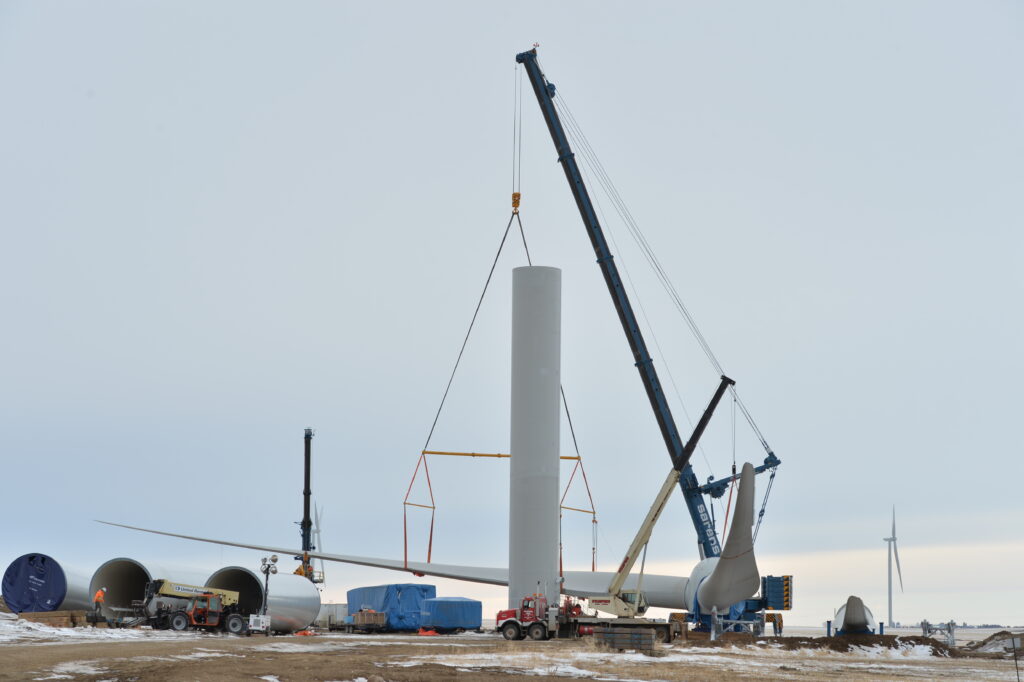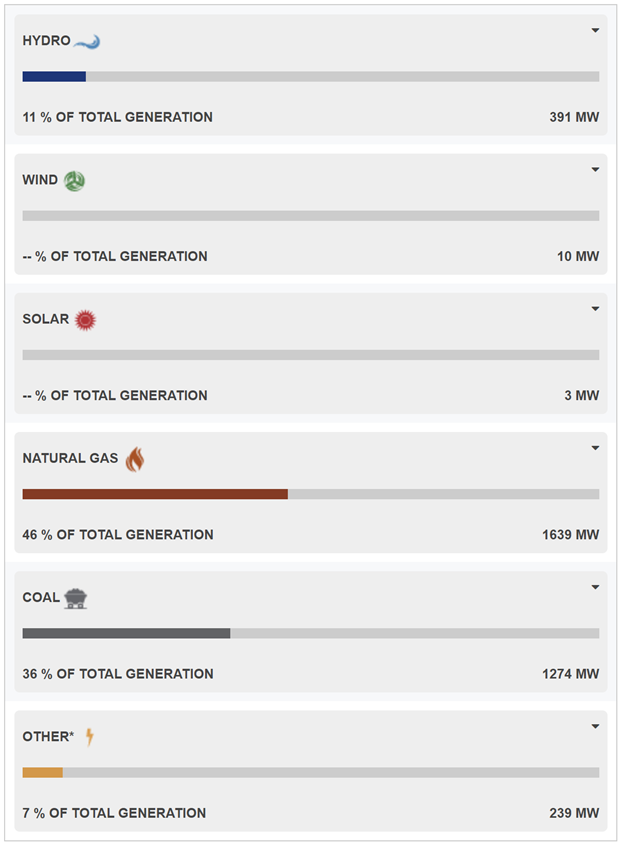Brian Zinchuk is editor and owner of Pipeline Online

Construction of the Golden South Wind Facility near Assiniboia in January, 2021. Photo by Brian Zinchuk
Just what would a “net zero” energy future look like, if Saskatchewan were to replace fossil fuels for power production with renewables? Enormous tracts of land would need to be covered with wind turbines and/or solar panels, never mind the batteries to back them up. Alternatively, 10 small modular reactors would do. But these numbers only account for usage last week, and not the growth of electrical vehicles in transportation, and the need to power them.
The figures come from Brahm Neufeld, an engineer from Saskatoon, who built a Twitter bot in September, 2022, to make Saskatchewan people more aware of just where their power is coming from. That bot is @SKElectricity. Its complimentary webpage is https://skelectricity.info.
And if you dig into those numbers, you will find that Saskatchewan would have needed 44,933 wind turbines covering 18.7 per cent of southern Saskatchewan on Feb. 23 to replace our natural gas and coal generation on that date. Please note, that’s my extrapolation, not Neufeld’s analysis.
Neufeld’s methodology can be found here, doing the best he can with SaskPower’s publicly released data on the “Where Your Power Comes From” webpage, information that is very limited in scope. In contrast, Dispatcho.app logs the Alberta Electric System Operator (AESO) data going back several years.
The Alberta Electric System Operator posts minute-by-minute updates of each generating station on its entire grid, right down to individual generating units of coal and natural gas facilities. This is key data, as Alberta’s power market is deregulated, whereas Saskatchewan’s is closed. Pipeline Online has reported on this extensively for the last 14 months, pointing out the frequent occasions where wind and or solar power in Alberta has ultimately failed (with wind generation falling to as low as three megawatts at times, with an installed fleet of wind generation that is now 3,618 megawatts in total across 36 wind farms).
- 0098 SASPO-2874_Self Serve Campaign_New Connects_Youtube_v30098 SASPO-2874_Self Serve Campaign_New Connects_Youtube_v3
- 0100 Turnbull Project Manager0100 Turnbull Project Manager
- 0099 Mryglod Steel 1080p0099 Mryglod Steel 1080p
- 0097 Eagle Sky Ventures LTD0097 Eagle Sky Ventures LTD
- 0095 Fast Trucking nearly 70 years good at it0095 Fast Trucking nearly 70 years good at it
- 0053 Kingston Midstream Westspur Alameda Click Before You Dig0053 Kingston Midstream Westspur Alameda Click Before You Dig
- 0092 Turnbull projects big and small0092 Turnbull projects big and small
- 0046 City of Estevan This is Estevan Teaser0046 City of Estevan This is Estevan Teaser
- 0087 Lori Carr Coal Expansion0087 Lori Carr Coal Expansion
- 0077 Caprice Resources Stand Up For Free Speech0077 Caprice Resources Stand Up For Free Speech
- 0076 Latus only0076 Latus only
- 0061 SIMSA 2024 For Sask Buy Sask0061 SIMSA 2024 For Sask Buy Sask
- 0055 Smart Power Be Smart with your Power office0055 Smart Power Be Smart with your Power office
- 0051 JML Hiring Pumpjack assembly0051 JML Hiring Pumpjack assembly
- 0049 Scotsburn Dental soft guitar0049 Scotsburn Dental soft guitar
- 0041 DEEP Since 2018 now we are going to build0041 DEEP Since 2018 now we are going to build
- 0032 IWS Summer hiring rock trailer music
- 0022 Grimes winter hiring
- 0021 OSY Rentals S8 Promo
- 0018 IWS Hiring Royal Summer
- 0013 Panther Drilling PO ad 03 top drive rigs
- 0006 JK Junior
- 0002 gilliss casing services0002 gilliss casing services
- 9002 Pipeline Online 30 sec EBEX9002 Pipeline Online 30 sec EBEX
- 9001
September 21, 2022, is when SaskPower started putting out daily data on its power production. This data is a daily average, and breaks down power generation into generation classes – coal, natural gas, hydro, wind, solar and “other,” which includes power purchases from Manitoba Hydro and small scale power producers (including small scale wind and solar). It’s also a daily average of each class. The data is released at midnight each day, with a two-day delay, so that SaskPower does not endanger its bargaining position in the continual power market exchange with its neighbours.

On Feb. 23, 2023, SaskPower saw its 617 megawatts of installed wind capacity average just 10 megawatts of power throughout the day. That means that at times, it was lower than 10. Ten megawatts of wind generation was 1.6 per cent of installed wind capacity for that day. It wasn’t enough to register as even 1 per cent of total power production, despite wind making up 11.3 per cent of nameplate installed power generating capacity in Saskatchewan. SaskPower
In addition to daily updates logging SaskPower’s power generation from the sparse information made publicly available, Neufeld automatically logs, processes, and also frequently collates this data to add context. A weekly analysis runs on Fridays calculating just how many small modular reactors, wind turbines or solar panels would be needed to replace the province’s fossil power plants for the previous seven days. On Friday, March, 3, 2023, he pointed out, “These seven days we generated 186 gigawatt-hours from coal,” noting that would be a volume of 1,004 rail cars. Similarly, 264 gigawatt-hours of power were generated from natural gas, enough to fill 18,902 hot air balloons (perhaps because balloons are in the news in recent weeks).
#FossilFriday🦴 Coal🏭 & Natural Gas🔥. What replaces coal by the 2030 phase-out? Will Small Modular Reactors support long-term decarbonization? #baseload #firm #dispatchable #reliable #nuclear pic.twitter.com/8U6aOYHloS
— Saskatchewan Electricity Mix (@SkElectricity) March 3, 2023
If we were to replace all that fossil fuel with nuclear reactors of design SaskPower has chosen, the GE Hitachi BWRX-300 (300 megawatt), we would have needed 10 reactors. They would have consumed 0.55 cubic metres of uranium fuel.
But it would have alternatively take 1,769 wind turbines covering 1,201,800 acres, assuming these were four megawatt units like the recently installed Golden South Wind Facility near Assiniboia.
A side note, Neufeld uses the turbine to land density listed by the project website, which comes to 680 acres per turbine (more than a section of land per turbine). However, having visited the site personally several times, and taking a good look at both Google Earth and the project map, it looks more like an average of two turbines per section of land. So for my analysis, I will use 320 acres per turbine, or 566,080 acres.
Neufeld’s calculation includes a 37 per cent capacity factor, and would require redundancy for calm winds, with multi-day battery storage, backup power, interconnects, and even more turbines and land.
- 0098 SASPO-2874_Self Serve Campaign_New Connects_Youtube_v30098 SASPO-2874_Self Serve Campaign_New Connects_Youtube_v3
- 0100 Turnbull Project Manager0100 Turnbull Project Manager
- 0099 Mryglod Steel 1080p0099 Mryglod Steel 1080p
- 0097 Eagle Sky Ventures LTD0097 Eagle Sky Ventures LTD
- 0095 Fast Trucking nearly 70 years good at it0095 Fast Trucking nearly 70 years good at it
- 0053 Kingston Midstream Westspur Alameda Click Before You Dig0053 Kingston Midstream Westspur Alameda Click Before You Dig
- 0092 Turnbull projects big and small0092 Turnbull projects big and small
- 0046 City of Estevan This is Estevan Teaser0046 City of Estevan This is Estevan Teaser
- 0087 Lori Carr Coal Expansion0087 Lori Carr Coal Expansion
- 0077 Caprice Resources Stand Up For Free Speech0077 Caprice Resources Stand Up For Free Speech
- 0076 Latus only0076 Latus only
- 0061 SIMSA 2024 For Sask Buy Sask0061 SIMSA 2024 For Sask Buy Sask
- 0055 Smart Power Be Smart with your Power office0055 Smart Power Be Smart with your Power office
- 0051 JML Hiring Pumpjack assembly0051 JML Hiring Pumpjack assembly
- 0049 Scotsburn Dental soft guitar0049 Scotsburn Dental soft guitar
- 0041 DEEP Since 2018 now we are going to build0041 DEEP Since 2018 now we are going to build
- 0032 IWS Summer hiring rock trailer music
- 0022 Grimes winter hiring
- 0021 OSY Rentals S8 Promo
- 0018 IWS Hiring Royal Summer
- 0013 Panther Drilling PO ad 03 top drive rigs
- 0006 JK Junior
- 0002 gilliss casing services0002 gilliss casing services
- 9002 Pipeline Online 30 sec EBEX9002 Pipeline Online 30 sec EBEX
- 9001
SaskPower is currently building a 20 megawatt battery on the east side of Regina that will be able to provide power for at most a few hours at a time. “The 20-megawatt facility, to be built in northeast Regina, will be able to power up to 20,000 homes for one hour,” SaskPower said on March 18, 2022. That battery will cost $26 million.
And if the choice was to replace fossil fuel power generation in Saskatchewan with solar panels similar to the Highfield Solar Facility, operating at a “generous 25 per cent capacity factor,” it would take 31,422,857 solar panels covering 73,291 acres (114.5 sections of land, or 3.2 townships). This would also require redundancy for sunless times (night, cloudy weather, winter) multi-day battery storage, interconnects and the like.
How many wind turbines needed on Feb. 23, when the wind didn’t blow?
If you extrapolate from Neufeld’s number of turbines, my turbine density number, and SaskPower’s Feb. 23 data, you get some very interesting figures. On that date, SaskPower generated an average of 3,404 megawatts, of which 1,639 was from natural gas (46 per cent) and 1,274 megawatts came from coal (36 per cent). On that date, SaskPower’s total wind fleet, with a nameplate capacity of 617 megawatts, produced an average of 10 megawatts, or 1.6 per cent capacity. To replace the 2,913 megawatts generated by gas and coal, with 4 megawatt units like the ones installed at the Golden South Wind Facility (pictured at the top of the story), and having them run at 1.6 per cent capacity, you would need:
2,913 MW coal and natural gas / 10 MW produced by the fleet of current installed wind = 291.3 wind fleets
291.3 wind fleets x 617 MW installed wind nameplate capacity in the current fleet (operating at 1.6 per cent capacity) = 179,732.1 MW nameplate capacity
179,732.1 MW / 4 MW per wind turbine = 44,933 wind turbines.
And that assumes an even 10 megawatts throughout the day. In fact, that was an average, meaning there were times when wind generation was even lower, and thus even more wind turbines would have been needed, plus all the grid infrastructure to connect them.
And if 1,769 turbines at 37 per cent capacity would require 566,080 acres:
44,933 turbines at 1.6 per cent capacity / 1,769 turbines = 25.4
25.4 x 566,080 acres = 14,378,432 acres.
14,378,432 acres / 640 acres per section = 22,466 sections = 22,466 square miles of land
Total size of Saskatchewan = 251,700 square miles
22,466 square miles for wind power generation / 251,700 square miles total Saskatchewan land mass = 8.9 per cent of all of Saskatchewan.
And since the area of Saskatchewan below the treeline makes up approximately 120,000 square miles according to Google Earth:
22,466 square miles for wind / 120,000 square miles south of the treeline = 18.7 per cent of southern Saskatchewan covered in wind turbines, or every inch of Saskatchewan south of Gravelbourg.

Based on Saskatchewan wind power output on Feb. 23, the entire area bounded in yellow would be need to be covered with two wind turbines per square mile to make up for the coal and natural gas power generated on that day. Google Earth
If you use Neufeld’s density, which is the one reported by Golden South itself, then that map expand to everything south of Fort Qu’Appelle, which is this entire map shown.
That means, to completely replace existing coal and natural gas power generation with enough wind generation capacity to account for days like Feb. 23, 2023, you would need to build 44,933 wind turbines covering 18.7 per cent of Saskatchewan south of the treeline.
Or, you could do the same with 10 small modular reactors, covering a total of 2.5 square miles.
You decide.
Brian Zinchuk is editor and owner of Pipeline Online. He can be reached at brian.zinchuk@pipelineonline.ca.
- 0098 SASPO-2874_Self Serve Campaign_New Connects_Youtube_v30098 SASPO-2874_Self Serve Campaign_New Connects_Youtube_v3
- 0100 Turnbull Project Manager0100 Turnbull Project Manager
- 0099 Mryglod Steel 1080p0099 Mryglod Steel 1080p
- 0097 Eagle Sky Ventures LTD0097 Eagle Sky Ventures LTD
- 0095 Fast Trucking nearly 70 years good at it0095 Fast Trucking nearly 70 years good at it
- 0053 Kingston Midstream Westspur Alameda Click Before You Dig0053 Kingston Midstream Westspur Alameda Click Before You Dig
- 0092 Turnbull projects big and small0092 Turnbull projects big and small
- 0046 City of Estevan This is Estevan Teaser0046 City of Estevan This is Estevan Teaser
- 0087 Lori Carr Coal Expansion0087 Lori Carr Coal Expansion
- 0077 Caprice Resources Stand Up For Free Speech0077 Caprice Resources Stand Up For Free Speech
- 0076 Latus only0076 Latus only
- 0061 SIMSA 2024 For Sask Buy Sask0061 SIMSA 2024 For Sask Buy Sask
- 0055 Smart Power Be Smart with your Power office0055 Smart Power Be Smart with your Power office
- 0051 JML Hiring Pumpjack assembly0051 JML Hiring Pumpjack assembly
- 0049 Scotsburn Dental soft guitar0049 Scotsburn Dental soft guitar
- 0041 DEEP Since 2018 now we are going to build0041 DEEP Since 2018 now we are going to build
- 0032 IWS Summer hiring rock trailer music
- 0022 Grimes winter hiring
- 0021 OSY Rentals S8 Promo
- 0018 IWS Hiring Royal Summer
- 0013 Panther Drilling PO ad 03 top drive rigs
- 0006 JK Junior
- 0002 gilliss casing services0002 gilliss casing services
- 9002 Pipeline Online 30 sec EBEX9002 Pipeline Online 30 sec EBEX
- 9001
